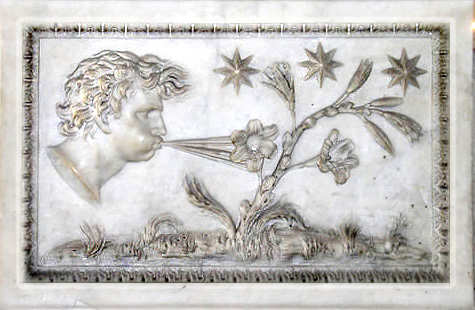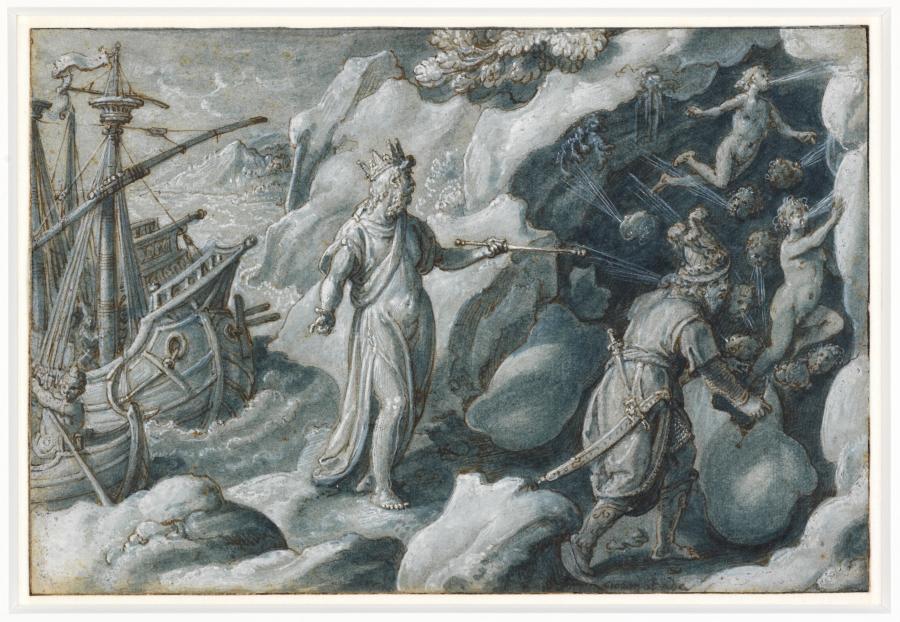Written by Jocelyn Hitchcock, Contributing Writer, Classical Wisdom
In Greek mythology the name Aeolus pops up in reference to three different characters: Aeolus, the son of Hippotes, and keeper of the winds; Aeolus, the half-human son of Poseidon; and Aeolus, the son of Hellen (not the Helen of the Trojan War, but a mortal ruler who is the legendary ancestor of the “Hellenic” people) and a nymph Orseis, who’s wife gave birth to a daughter, Arnes, who is said to have given birth herself to the Aeolus of Poseidon.
While the Aeolus of the Odyssey is clearly the god of the winds, later Roman writers such as Ovid conflate the Aeolus’ together. It’s all very confusing, but it wouldn’t be Greek mythology if it weren’t!
Here, we’re going to focus on Aeolus, the keeper of the winds, as he appears most prominent in myths of Odysseus and the larger Greek mythological universe. Aeolus, or Aiolos, was said to reside on the floating island of Aiolia/Aeolia.
In geographic terms, Aeolus is an area in the west and northwestern region of present day Turkey, along the coast, including the offshore islands. Instead of a specific island, the Aeolic region is one of shared cultural and linguistic traits. The island of Aeolia itself, where Aeolus was said to reside, has not been identified and itself is mythological.
Powers
The power of Aeolus rested in his control and desires of the winds. According to myth, Kronion or Zeus had made Aeolus ‘warden’ of the winds, so that at his pleasure he could order them to rise or fall or shift, whatever suited him.
He kept the violent storm winds locked away inside a cavern on the island, only releasing them upon order of one of the greatest gods. Aeolus knew of their power and knew he held the potential to wreak havoc on the world.
Appearance in the Odyssey
In the Odyssey, book 10, Odysseus describes the island as “a floating one,” and with a “wall of bronze, unbreakable, and rock[s rising] sheer above it.” Odysseus claims that Aeolus has 12 children living in his palace, six daughters and six sons, all paired off to one another.
“Then to the Aeolian isle we came, where dwelt Aeolus, son of Hippotas, dear to the immortal gods, in a floating island, and all around it is a wall of unbreakable bronze, and the cliff runs up sheer.”
According to the epic, Aeolus welcomed Odysseus and his men for a month, offering hospitality and encouraging Odysseus to relay the story of Ilium and the Argives. When it was time for Odysseus and his men to begin on their way again, Odysseus asked for help from the god of the winds, with Aeolus granting Odysseus a bag made of ox hide, filled with every wind that blows, regardless of the direction.
To this, Aeolus placed the bag in Odysseus’ ship hold, “tied with a glittering silver cord,” and gave the westward wind instruction to blow alone, carrying Odysseus and his men home.
“But when I, on my part, asked him that I might depart and bade him send me on my way, he, too, denied me nothing, but furthered my sending. He gave me a wallet, made of the hide of an ox nine years old, which he flayed, and therein he bound the paths of the blustering winds; for the son of Cronos had made him keeper of the winds, both to still and to rouse whatever one he will. And in my hollow ship he bound it fast with a bright cord of silver, that not a breath might escape, were it never so slight. But for my furtherance he sent forth the breath of the West Wind to blow, that it might bear on their way both ships and men. Yet this he was not to bring to pass, for we were lost through our own folly.”
It wouldn’t be the Odyssey, though, if there wasn’t some snap in the plan. Odysseus himself claimed that it was their own “folly” that ruined them. According to the epic, the ship was in sight of their land on the 10th day sailing from Aeolus. They could see the fires of their shores.
However, the crew, positive that Odysseus was bringing home riches from Aeolus, opened the bag of winds to see for themselves. At this, the winds rushed out all at once and hurled the ship back to the open waters and to the shores of Aeolus once again.
When the keeper of the winds questioned Odysseus as to why they had returned, Odysseus admitted it was the result of his foolish crew. Aeolus said he was forsaken by the gods and banished him from the island, without any further help.
“`How hast thou come hither, Odysseus? What cruel god assailed thee? Surely we sent thee forth with kindly care, that thou mightest reach thy native land and thy home, and whatever place thou wouldest.’“So said they [Aeolus with his wife and children], but I with a sorrowing heart spoke among them and said: `Bane did my evil comrades work me, and therewith sleep accursed; but bring ye healing, my friends, for with you is the power.’“So I spoke and addressed them with gentle words, but they were silent. Then their father answered and said: `Begone from our island with speed, thou vilest of all that live. In no wise may I help or send upon his way that man who is hated of the blessed gods. Begone, for thou comest hither as one hated of the immortals.’”
Depictions
Artistic depictions of Aeolus were not very popular, perhaps due to the muddled nature of the three Aeolus’, or perhaps due to the more attractive subjects of greater gods and stories. Roman and Sicilian renderings of Aeolus show a male face with the lips blowing at the earth, a tree, the ocean, etc. More paintings and drawings of Aeolus became common during the Renaissance, but still they are not copious.
After all, the wind isn’t something you see, it’s something you feel. And no painting can capture the power of the god of the winds!













One comment
According to the Odyssey and the main mythographers Aeolus is a human being, the king or keeper of the winds, not a divinity, only some later authors count him among the gods.
Our apologies, you must be logged in to post a comment.